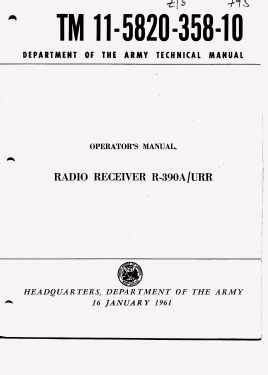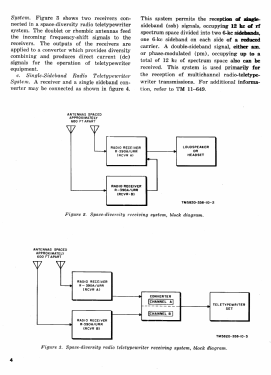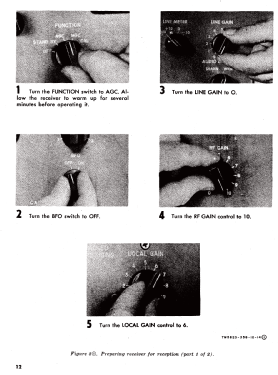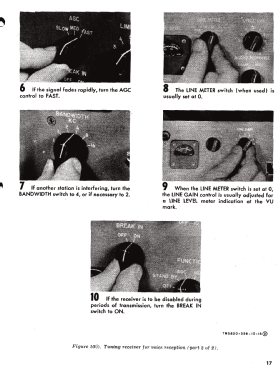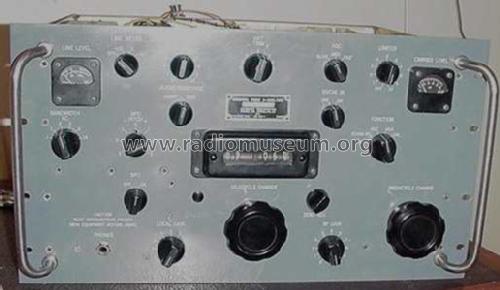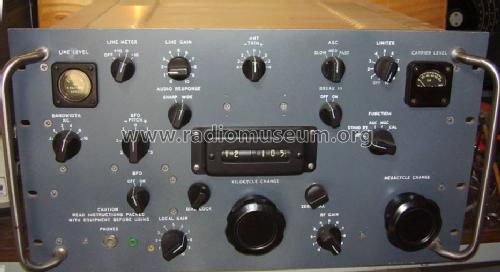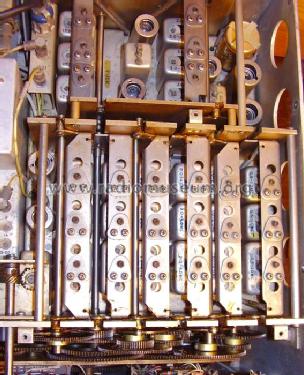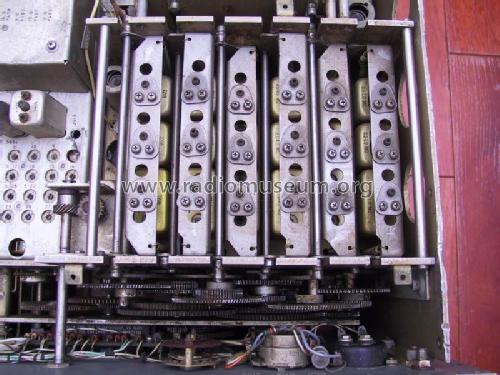- Country
- United States of America (USA)
- Manufacturer / Brand
- MILITARY U.S. (different makers for same model)
- Year
- 1954–1985
- Category
- Military Receiver
- Radiomuseum.org ID
- 68887
Click on the schematic thumbnail to request the schematic as a free document.
- Number of Tubes
- 24
- Valves / Tubes
- 6DC6 6AK5W 6AK5W 6C4 6C4 6C4 6BA6W 6BA6W 6BA6W 6BA6W 6BA6W 6BA6W 6AK6 6AK6 6AK6 5814A 5814A 5814A 5814A 5814A 5814A 5814A 26Z5W 26Z5W 3TF7 0A2
- Main principle
- Superhet with RF-stage
- Wave bands
- Broadcast plus more than 2 Short Wave bands.
- Power type and voltage
- Alternating Current supply (AC) / 115/230 Volt
- Loudspeaker
- - This model requires external speaker(s).
- Material
- Metal case
- from Radiomuseum.org
- Model: R-390A/URR - MILITARY U.S. different makers
- Shape
- Rack
- Dimensions (WHD)
- 19 x 10.5 x 16 inch / 483 x 267 x 406 mm
- Notes
- AM/CW/MCW; dual/triple conversion; (32) 1-MHz bands; xtal and mech. filter. 54000 sets made by Collins and other manufacturers as well Motorola, Stewart-Warner, EAC, Capehart, AMELCO, Fowler, Teledyne, Dittmore-Freimuth and Helena Rubenstein (last was original, but relabled Collins).
- Net weight (2.2 lb = 1 kg)
- 29.5 kg / 64 lb 15.6 oz (64.978 lb)
- Price in first year of sale
- 2,500.00 $
- External source of data
- Konrad Birkner
- Mentioned in
- Communications Receivers
- Literature/Schematics (1)
- Shortwave Receivers - Past & Present (3rd ed.)
- Author
- Model page created by Konrad Birkner † 12.08.2014. See "Data change" for further contributors.
- Other Models
-
Here you find 402 models, 354 with images and 211 with schematics for wireless sets etc. In French: TSF for Télégraphie sans fil.
All listed radios etc. from MILITARY U.S. (different makers for same model)
Collections
The model is part of the collections of the following members.
- Konrad Birkner † 12.08.2014 (D)
- Martin Bösch (CH)
- Chou Chiang-ping (TW)
- Emilio Ciardiello (I)
- Josep Garcia-Menchon (E)
- Hidehiro Hirose (J)
- Thomas Leiper (USA)
- James Miller (USA)
- Musée des Radios Museum (CH)
- Bryce Ringwood (ZA)
- Fabio Sarcina di Fidio (I)
- Ioannis Tzavaras (GR)
- Georges Werts (B)
- Christian Willers (D)
- Robert Ziolkowski (USA)
- Mümin Önüt (D)
Museums
The model can be seen in the following museums.
Forum contributions about this model: MILITARY U.S.: R-390A/URR
Threads: 2 | Posts: 2
Having to pull the RF Deck to clean the bandchange switch wafers (a chore that I seem to have to do every two tyears or so) reminded me of the need to re download the Y2K manual http://www.hausernet.com/r390a/ . This is not the original technical manual mentioned in previous posts.
Thanks to the authors for putting this together. Apologies to forum members who may have this revised manual with some colour pictures, but it may be of interest to new owners.
Bryce Ringwood, 02.Aug.09
R-725 is a direction-finding set with an IF strip similar to the R-390, developed by Motorola and built by Servo and Arvin. No more than 300 sets produced.
R-1274/GRC-129 model is a special variant, widely in use by the NASA for the APOLLO effort.
For further information see Fred Osterman: Shortwave-Receivers - past and present.
Eilert Menke, 23.Apr.04










